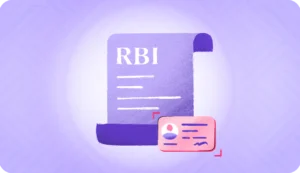Due to regulatory and compliance requirements, loan agreements are often complex documents. As a result, they can be hard to understand for the layman, and any miscommunication or misunderstanding can result in legal problems.
To solve this issue, the Reserve Bank of India has mandated the creation of the Key Facts Statement (KFS) for loan agreements.
It is a standardized document that provides the essential details of the loan. It aims to increase transparency in the loan process by providing the most important information as clearly as possible.
The Key Facts Statement (KFS) aims to provide support to the borrower as well as lenders. The increased transparency of the process makes it easier to use and streamlines the process of loaning.
The guidelines have mandated that all lenders provide a Key Facts Statement (KFS) document to the borrowers, and then acquire an acknowledgement confirming that the borrowers have understood all of the details in the loan agreement.
This way, the borrowers can confirm that they are fully informed of the details of the loan.
Since it is meant to apply to any entity that engages in lending, the Key Facts Statement (KFS) is applicable to all regulated entities. This includes:
- All Commercial Banks (including Small Finance Banks, Local Area Banks, and Regional Rural Banks, excluding Payments Banks)
- All Primary (Urban) Co-operative Banks, State Co-operative Banks and Central Co-operative Banks
- All Non-Banking Financial Companies (including Housing Finance Companies)
All regulated entities need to send a KFS document for any loans sanctioned on or after 1st October 2024, which includes new loans to existing customers. To be more specific, all new retail and MSME loans require KFS documents to be provided to the borrower.
Key components of the Key Facts Statement (KFS)
For a Key Fact Statement (KFS) to follow the mandate, it needs to contain the following key components.
- Loan Amount and Term: It needs to specify the principal amount being borrowed, as well as the total duration over which the loan needs to be paid, i.e., the terms of the loan.
- Interest Rate: It needs to specify the interest rate of the loan, and whether it is fixed, floating, or hybrid. In the case of floating rates, it needs to clarify the reference benchmark, the benchmark rate, and a few other details. It also needs to disclose the Annual Percentage Rate (APR), which shows all costs associated with the loan. This should give a clear picture of the effective cost and interest rate to the borrower.
- Processing fees: It needs to list all the fees associated with the loan, such as processing fees and administrative fees, ensuring that there are no hidden charges.
- Prepayment terms: It needs to explain any rules regarding prepayment of the loan, especially in the case of prepayment penalties or foreclosure.
- Repayment schedule: It needs to provide a detailed breakdown of the repayment process and terms, including the installment frequency as well as the amount. It should also include an amortization schedule, which breaks down how each payment is divided between interest and principal.
- Grievance redressal: It needs to explain the process of grievance redressal, helping borrowers with their complaints or issues with the loan agreement.
Benefits of KFS for borrowers
The Key Facts Statement provides a number of benefits to borrowers, helping them make better, more informed decisions. These benefits include:
- Increased transparency: The Key Facts Statement (KFS) outlines all the important details of the loan agreement, breaking down the interest rates, fees, and repayment details. This helps the borrower understand all of the financial obligations listed in the KFS while making sure that there are no hidden fees in the loan agreement.
- Informed decision-making: By clarifying all the relevant details of the loan, the KFS makes sure that the borrower can compare any loans they may wish to take. By making all of the decisions from an informed perspective, borrowers are empowered with greater control over their finances.
- Protection against hidden costs: Since the KFS mandates that all costs associated with the loan must be listed, predatory loan companies can no longer apply hidden costs to increase the borrower’s financial burden.
- Legal clarity: The KFS makes sure that the borrower understands the full legal obligations expected of them with regards to the loan. Also, it helps them understand all of the rights that are due to them as well.
Benefits of KFS for lenders
While the Key Facts Statement (KFS) provides plenty of benefits to borrowers, it benefits lenders a great deal too.
Some of the benefits enjoyed by lenders include:
- Enhanced customer trust: By providing clear and concise details of the loan in the KFS, lenders can ensure higher levels of customer trust. The KFS also makes sure that misunderstandings are reduced, which leads to higher levels of customer satisfaction.
- Reduced disputes and delinquencies: By greatly increasing the amount of information available to the borrower, the KFS makes it much more likely that they understand all of the rights and obligations they have. This, in turn, greatly reduces the number of disputes and delinquencies, as borrowers are much less likely to default on their loans.
- Loan process streamlining: By standardizing the KFS format, the RBI has helped streamline the process of loaning. Since it presents the loan agreement information in a consistent format, it helps lenders process applications much faster.
- Promotes responsible lending: By making sure that all fees and charges are disclosed in the KFS, it makes it much harder for predatory lenders to operate, while also helping normal lenders with regulatory compliance.
Compliance with KFS guidelines
Understanding the KFS guidelines
There are several RBI circulars and notifications that contain the relevant information about the new KFS mandates. The full details can be found in the link below.
It contains the notification put forth by the RBI, as well as the Annexes which demonstrate how a KFS document is to be framed.
Key Facts Statement (KFS) for Loans & Advances (PDF)
When it comes to implementing the KFS mandates, regulated entities need to make sure that the KFS is acknowledged before the loan documents are signed.
As such, regulated entities either send the KFS document before the loan documents, or, if they send all the documents together, they require the KFS document to be sent back first.
How to create a KFS document
When creating a KFS document for a loan, it is necessary to follow RBI mandates. As such, it needs to contain all the essential information, which includes but is not limited to:
- Loan amount
- Interest rate
- Processing fees
- Repayment schedule
- Grievance redressal mechanism
The RBI mandate also includes a clause for clarity, As such, the KFS must also be written in the language spoken by the borrower. The KFS must also be customized according to the loan that the borrower wishes to take.
Implementing KFS Compliance Processes
As a regulated entity, it is necessary to implement KFS compliance processes.
The first step is building a centralized repository of the KFS documents for every single loan product offered by the lender.
This repository should contain all the standardized templates in all relevant languages, as well as any updates or amendments thereof.
The repository should also be easily accessible to all relevant staff.
The second step is to train all relevant staff.
The training should include information about all of the KFS mandates, the guidelines set forth, and the procedures for getting borrowers to understand the KFS document and getting their acknowledgements.
Finally, a regular review and audit process should be set up to ensure that all of the KFS regulations are being complied with.
Leveraging Technology for KFS Compliance
Complying with KFS guidelines can be somewhat challenging. Thankfully, it is possible to leverage technology to streamline and simplify the process of KFS compliance.
It is possible to automate the process of generating digital KFS documents in a standardized format. This ensures that the document contains all the relevant information, and can be easily translated into any language needed by the borrower.
Secondly, by using methods like HyperVerge’s Aadhar eSign, the process of KFS verification can be streamlined while maintaining regulatory compliance and data security of the borrower.
By integrating KFS compliance modules into the Loan Origination System, lenders can take advantage of data analytics to monitor compliance.
Addressing Common Challenges in KFS Compliance
While KFS compliance greatly eases the process of loan management, there are certain challenges that can affect efficiency.
Data accuracy
The first of these challenges, data accuracy, is a major one.
If there is inaccurate data in the KFS document, it can have major negative effects for the borrower, while lenders can face severe regulatory penalties.
To avoid this problem, it is best to automate the process of generating KFS documents, by pulling loan information directly from the Loan Origination System.
Secondly, regular audits also help with identifying discrepancies in things like interest rates, loan terms, fees and the like.
Timely delivery
The second most common challenge with KFS is timely delivery.
The RBI has mandated that it needs to be given to the borrower before any actual loan documents are shared and that it will have a validity period of at least three working days for any loan that has a tenure of seven days or more, and a validity period of one working day for any loan that has a tenure of less than seven days.
Due to these requirements, it is necessary to have the borrowers receive the KFS and send the acknowledgement as soon as possible. This process can be simplified using tools like Aadhar eSign.
Grievance redressal
The third major challenge is grievance redressal.
To solve issues with grievance redressal, lenders need to have robust redressal mechanisms.
They need to develop clear procedures to escalate any grievances as needed.
These grievances must then be tracked and analyzed to make sure that the root cause does not recur.
Conclusion
The new KFS mandates are designed to help both borrowers and lenders, but implementing them properly can be somewhat complex.
Luckily, there are technological solutions available to simplify the process of regulatory compliance.
By using tools like HyperVerge’s Aadhar eSign, KFS compliance can be simplified greatly.
The added data security and ID verification capabilities help maintain regulatory compliance while also making things easier for borrowers.
Learn more about keeping your lending processes compliant with KFS and speeding up the eSign process – click here or book a demo!
FAQs
What are the penalties for non-compliance with KFS guidelines?
Non-compliance with KFS guidelines can result in severe penalties for offending entities. The RBI has the authority to issue warnings, impose fines, and in severe cases, restrict the lending capabilities of the offending entity until they adhere to KFS guidelines.
How long is a KFS valid for?
For any loan lasting longer than seven days, the KFS is valid for three days. For any loan lasting less than seven days, the KFS is valid for one day.
In which language should the KFS be provided to the borrower?
The Reserve Bank of India has mandated that the KFS for the loan agreement should be provided in whichever language the borrower can understand. As such, it is necessary to keep all relevant translations of the KFS.
What are the different types of loans that require a KFS?
The different types of loans that require a KFS are retail and MSME loan products only. Credit card receivables are exempted.




